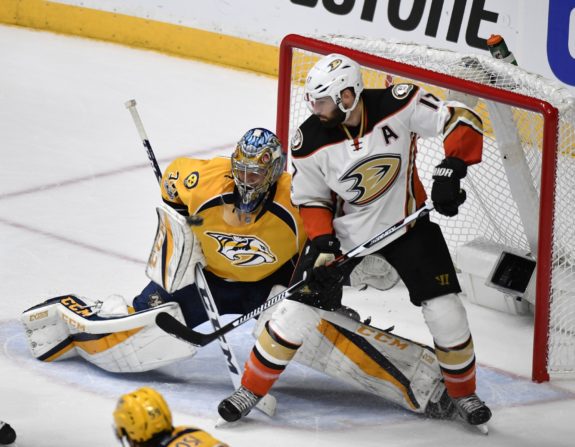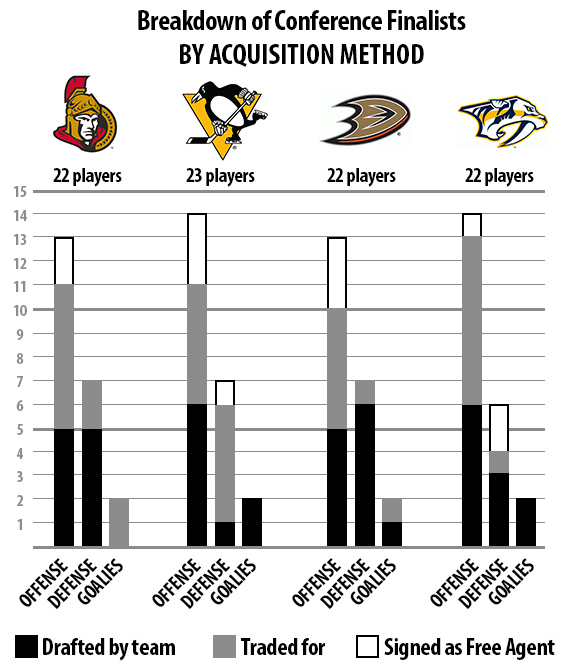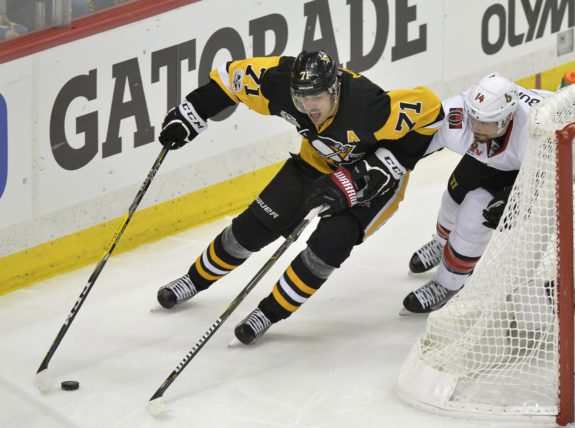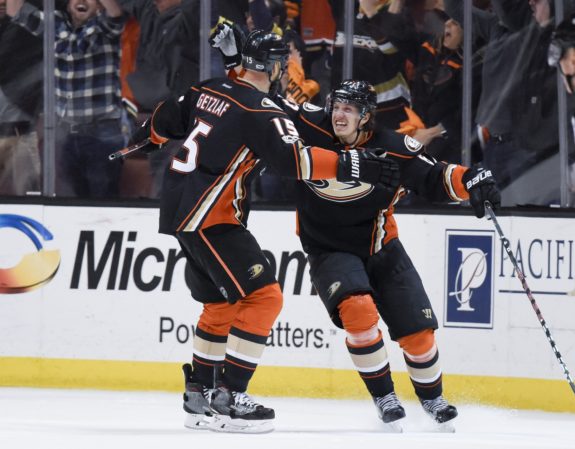Whether you want to be able to play a hard-hitting, ‘heavy’ game, a strangling defensive system or a fast-paced skill game, championship teams still need timely scoring, shutdown defense, and a hot goalie, all traits of a Stanley Cup-winning team.

Different teams find different solutions, each according to their own situation. Some teams find that they have accumulated a plethora of draft picks because they haven’t played well. Others have cap space and can be more active in the free agent market. Still others have to make old-fashioned ‘hockey trades’—players for players—because of financial considerations and the uncertainty of draft prospects panning out.
But how do you put together a roster with the right mix of scorers, playmakers, role players and defensive depth? Where do you find them?
Breaking Down the Conference Finalists
This article takes an in-depth look at the four 2016-17 Conference Finalists. In the east, that’s the Pittsburgh Penguins and the Ottawa Senators. In the west, it’s the Nashville Predators and the Anaheim Ducks.
At the start of the season, every NHL team must submit a playing roster of not more than 23 players. While that number increases in the playoffs, for the purposes of this article, only players who competed in at least one of the following games are included:
- Players in the lineup from Game 1 of their respective first-round playoff series
- Players in the lineup for Game 2 of the Penguins-Senators series
- Players in the lineup for Game 3 of the Ducks-Predators series
This allows for an element of lineup changes and injuries.
For the Senators, 22 players (13 forwards, 7 defensemen and 2 goalies) were considered.
For the Penguins, 23 players (14 forwards, 7 defensemen and 2 goalies) were considered.
For the Ducks, 22 players (14 forwards, 7 defensemen and 2 goalies) were considered.
For the Predators, 22 players (14 forwards, 6 defensemen and 2 goalies) were considered.
Looking at the Four Rosters
This graphic plots each team’s players (as determined eligible by the criteria above) by position and how they were signed.

Of the 89 players included, 42 were drafted by their current team (47 percent), 35 were acquired by trade (39 percent) and 12 were signed as free agents (13 percent). Each team had roughly the same proportion of players in each category.
A few interesting things to note:
- Ottawa and Anaheim have drafted most of their defensemen, while Pittsburgh has traded for most of theirs.
- Ottawa has acquired their goalies by trade, while the Predators have drafted both of theirs.
- Players on offense make up an overwhelming majority of those signed as free agents (nine out of twelve players for 75 percent).
- None of the 12 players who signed as free agents and were a restricted free agent were offer-sheeted. (Some of the better targets for free agents tend to be bottom-six forwards or bottom-pair defensemen.)

Inside the Ottawa Senators’ Roster
Of the 22 players to have played for Ottawa, less than a quarter of them were drafted in the first two rounds. Forty percent came from round three through five. Thirty-six percent were drafted in the sixth round or later, or undrafted.
The Senators have dressed thirteen different forwards.
- Five were drafted by the organization.
- Six were acquired by trade.
- Two signed as a free agent.
Of the seven defensemen:
- Five were drafted by the organization.
- Two were acquired by trade.
Both goalies were acquired by trade.

Inside the Pittsburgh Penguins’ Roster
Of the 23 players to have suited up for the Penguins, more than half (53 percent) were either drafted in the first or second round. Roughly one-third were drafted in the sixth round or later, or undrafted.
Of the fourteen forwards who have dressed:
- Six were drafted by the organization.
- Five were acquired by trade.
- Three signed as a free agent.
Of the seven defensemen:
- One was drafted by the organization.
- Five were acquired by trade.
- One signed as a free agent.
Both goalies were drafted by the organization.
Inside the Anaheim Ducks’ Roster
Of the 22 players to have played for the Ducks, more than two-thirds (68 percent) were drafted in the first two rounds. Only eighteen percent came from round three through five. Only 13 percent were drafted in the sixth round or later, or undrafted
Of the thirteen forwards who have dressed:
- Five were drafted by the organization.
- Five were acquired by trade.
- Three signed as a free agent.
Of the seven defensemen:
- Six were drafted by the organization.
- One was acquired by trade.
One goalie was drafted by the organization, one was acquired by trade.

Inside the Nashville Predators’ Roster
Of the 22 players to have played for Nashville, more than half (59 percent) were drafted in the first two rounds. Less than one quarter came from round three through five. Only 18 percent were drafted in the sixth round or later, or undrafted.
Of the 14 forwards who have dressed:
- Six were drafted by the organization.
- Seven were acquired by trade.
- One signed as a free agent.
Of the six defensemen:
- Three were drafted by the organization.
- One was acquired by trade.
- Two signed as a free agent.
Both goalies were drafted by the organization.
Having A Philosophy
So much goes into building a Stanley Cup-caliber team. Finding the right mix of players to complement one another takes a staff that specializes in scouting and drafting. It’s not a science.
Even if you have the very best players at each position, you’re not guaranteed anything. Sure, your chances of winning may seem higher at first, but it takes more than skill. Take, for example, the story of the “Miracle on Ice” back in the 1980 Olympics, when Coach Herb Brooks led Team USA to gold over the Russians. They weren’t chock-full of skilled individuals; rather, they were quality players who worked together to win.

Brooks’ way of building a team has long been documented. He picked his team by bringing together a bunch of random players—young players and no-namers—going against the wisdom of his assistant coaches and team advisors.
In the movie, the conversation went something like this:
Herb’s assistant, Craig Patrick: This is the final roster? You’re kidding me, right? This is our first day, Herb. We’ve got a week of this. What about the advisory staff? Aren’t they supposed to have a say in this? You’re missing some of the best players.
Herb responds: I’m not looking for the best players, Craig. I’m looking for the right ones.
Brooks’ response epitomized his approach. He understood who should be in each position. He had spent countless hours studying the opposition and knowing EVERY player he might possibly have on his team before he actually knew he was to coach the team. History tells us his strategy was right.
The Salary Cap
Building a competitive team is also all about budgeting. The salary cap is designed to promote parity and competitiveness among all teams, regardless of their market size.
Working the salary cap is a skill that’s increasingly more complicated than ever. A team can choose to spend multimillions on contracts that lock up star players and then have less money compared to other teams to spend for complementary-players.
Then there are role players. And the question of youth vs. experience to consider. While past performance does not always equate to future success, there’s no denying how valuable is it to have a Stanley Cup Champion on your roster, who’s “been there.”
The Core – Depth Mix
A common theme to building a consistent Cup contender is to establish a core and surround it with relatively cheap and competent depth. All Stanley Cup champions have a core of players that are the foundation of their competitiveness and lead the charge.
The shining example of this is the Blackhawks and their three Cup wins. At the heart of each win were the same seven players: Jonathan Toews, Marian Hossa, Patrick Kane, Patrick Sharp, Duncan Keith, Brent Seabrook and a goalie (Antti Niemi followed by two wins from Corey Crawford).

While the cast around these seven was constantly changing, the core remained. They were the engine propelling the team to victory. Most cores are comprised of two centers, two defensemen, a winger, another forward, and a goalie. Surrounding them with cheap yet competent depth is a must. Young talent on entry-level contracts is also the lifeblood of a team. As they mature and finish their contracts, the older, expensive yet expendable senior players have to be moved.
Lastly, while goaltending is important, it’s debatable whether you need an elite one to win a Cup. It’s highly unlikely anyone thought Pekka Rinne, John Gibson, and Craig Anderson would be among the Conference Finalist goalies. Rinne is the third-highest paid goalie in the league ($7 million), Marc-Andre Fleury is the 14th ($5.75 million), Anderson is the 22nd ($4.75 million) and Gibson is the 34th ($1.5 million). Matt Murray is the 120th (making “only” $575,000).
Finding a Winning Formula
There is no one ‘right’ way to build a winner. If it was that easy, there’d be no reason to play the game – the Cup winner could be determined on paper. A blueprint is just that: a plan to guide you. Things like injuries, team chemistry, and coaching issues mean rosters are always in a state of flux.
The same Chicago Blackhawks team that was used as a shining example was swept by the Nashville Predators in the first round this year.
Every team in the Conference Finals faces its own unique circumstances and challenges, with a style of play that suits its roster. For example, Ottawa’s defensive style would hardly work well for Pittsburgh’s roster.
It’ll be interesting to see which teams advance to the Cup Final and who gets to hoist the Cup.